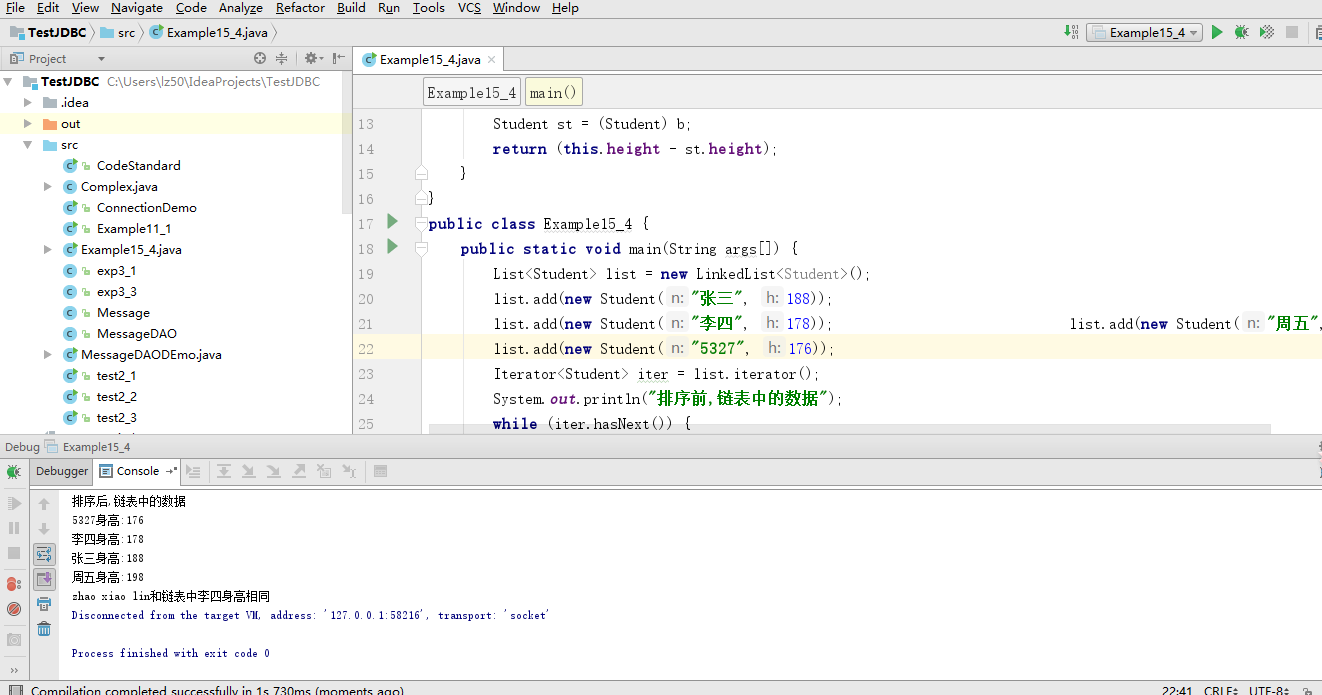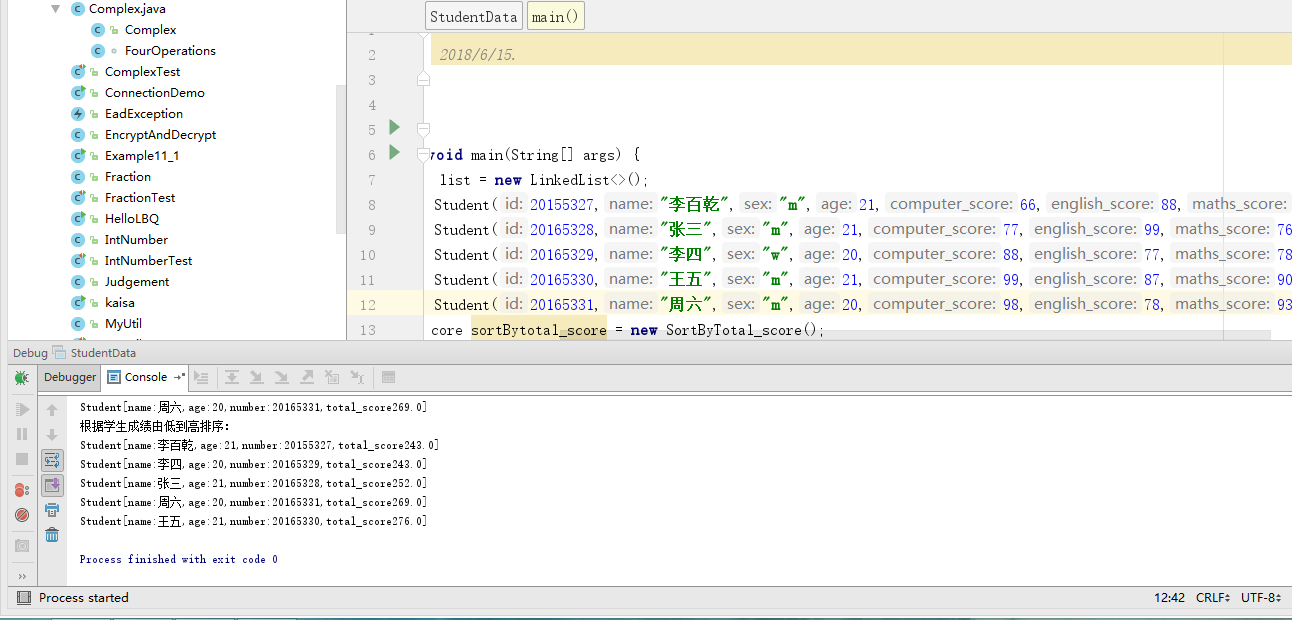实践一
教材p448 Example15_4
- list中增加自己学号后三名同学,学号是最后三名的从1号开始加入
- 提交运行结果截图
- 刻下推送代码到码云
题目分析:
将代码简单修改学号姓名就好
截图如下:

实践二
数据结构和算法中,排序是很重要的操作,要让一个类可以进行排序,有两种方法:
- 有类的源代码,针对某一成员变量排序,让类实现Comparable接口,调用Collection.sort(List)
- 没有类的源代码,或者多种排序,新建一个类,实现Comparator接口 调用Collection.sort(List, Compatator)
针对下面的Student类,使用Comparator编程完成以下功能:
- 在测试类StudentTest中新建学生列表,包括自己和学号前后各两名学生,共5名学生,给出运行结果(排序前,排序后)
- 对这5名同学分别用学号和总成绩进行增序排序,提交两个Comparator的代码
- 课下提交代码到码云
题目分析:
comparator接口(01,02)->{}
排序默认是按照升序排序
如果返回-1,就认为01 小于02,(注意01和02的顺序)
如果返回0,认为两个相等
如果返回1,就认为01大于02,(注意01和02的顺序)
对student对象数组进行排序,用的sort方法,在实现comparator接口时,sort方法需要传进来两个参数,即stu对象数组,以及重写的实现了comparator比较方法类。
代码如下:
import java.util.*;
class StudentData {
public static void main(String[] args) {
List<Student> list = new LinkedList<>();
list.add(new Student(20155327,"李百乾","m",21,66,88,89));
list.add(new Student(20165328,"张三","m",21,77,99,76));
list.add(new Student(20165329,"李四","w",20,88,77,78));
list.add(new Student(20165330,"王五","m",21,99,87,90));
list.add(new Student(20165331,"周六","m",20,98,78,93));
SortByTotal_score sortBytotal_score = new SortByTotal_score();
Collections.sort(list, sortBytotal_score);
SortByID sortByID = new SortByID();
Collections.sort(list, sortByID);
System.out.println("根据学生学号由低到高排序:");
for (Student student : list) {
System.out.println(student);
}
Collections.sort(list, sortBytotal_score);
System.out.println("根据学生成绩由低到高排序:");
for (Student student : list) {
System.out.println(student);
}
}
}
class Student {
private int id;//表示学号
private String name;//表示姓名
private int age;//表示年龄
private String sex;//表示性别
private double computer_score;//表示计算机课程的成绩
private double english_score;//表示英语课的成绩
private double maths_score;//表示数学课的成绩
private double total_score;// 表示总成绩
private double ave_score; //表示平均成绩
@Override
public String toString() {
return "Student[name:"+name+",age:"+age+",number:"+id+",total_score"+total_score+"]";
}
public Student(int id, String name, String sex, int age, double computer_score, double english_score, double maths_score) {
this.id = id;
this.name = name;
this.sex = sex;
this.age = age;
this.computer_score = computer_score;
this.english_score = english_score;
this.maths_score = maths_score;
}
public String getName() {
return name;
}
public int getId() {
return id;
}//获得当前对象的学号,
public double getComputer_score() {
return computer_score;
}//获得当前对象的计算机课程成绩,
public double getMaths_score() {
return maths_score;
}//获得当前对象的数学课程成绩,
public double getEnglish_score() {
return english_score;
}//获得当前对象的英语课程成绩,
public void setName(String name) {
this.name = name;
}
public void setId(int id) {
this.id = id;
}// 设置当前对象的id值,
public void setComputer_score(double computer_score) {
this.computer_score = computer_score;
}//设置当前对象的Computer_score值,
public void setEnglish_score(double english_score) {
this.english_score = english_score;
}//设置当前对象的English_score值,
public void setMaths_score(double maths_score) {
this.maths_score = maths_score;
}//设置当前对象的Maths_score值,
public double getTotalScore() {
total_score=computer_score + maths_score + english_score;
return total_score;
}// 计算Computer_score, Maths_score 和English_score 三门课的总成绩。
public double getAveScore() {
return getTotalScore() / 3;
}// 计算Computer_score, Maths_score 和English_score 三门课的平均成绩。
}
class SortByID implements Comparator<Student> {
@Override
public int compare(Student o1, Student o2) {
return o1.getId() - o2.getId();
}
}
class SortByTotal_score implements Comparator<Student> {
@Override
public int compare(Student o1, Student o2) {
return (int)( o1.getTotalScore() - o2.getTotalScore());
}
}
截图如下

实践三
参见附件,补充MyList.java的内容,提交运行结果截图(全屏)
课下推送代码到码云
题目分析:
1.编写一个Node类来充当结点的模型。我们知道,其中有两个属性,1存放数据的data,2存放下一结点的引用
public class Node<T> //单链表结点类,T指定结点的元素类型
{
public T data; //数据域,存储数据元素
public Node<T> next; //地址域,引用后继结点
public Node(T data, Node<T> next) //构造结点,data指定数据元素,next指定后继结点
{
this.data = data; //T对象引用赋值
this.next = next; //Node<T>对象引用赋值
}
public Node()
{
this(null, null);
}
@Override
public String toString() //返回结点数据域的描述字符串
{
return this.data.toString();
}
}
2.单链表的简单操作(增加,删除,获取总长度,链表元素排序,链表遍历):
增加结点操作,addNode(Node):通过移动的指针遍历整个链表,找到最后一个结点,往后添加即可
插入结点到链表的指定位置。 insertNodeByIndex(int index,Node node)
删除指定位置上的结点 delNodeByIndex(int index)
代码如下:
/**
* Created by lz50 on 2018/6/15.
*/
public class MyList {
public static void main(String[] args) {
//选用合适的构造方法,用你学号前后各两名同学的学号创建四个结点
Node<Integer> S1 = new Node<Integer>(20155325, null);
Node<Integer> S2 = new Node<Integer>(20155326, null);
Node<Integer> S3 = new Node<Integer>(20155328, null);
Node<Integer> S4 = new Node<Integer>(20155329, null);
//把上面四个节点连成一个没有头结点的单链表
S1.next = S2;
S2.next = S3;
S3.next = S4;
//遍历单链表,打印每个结点的
Node<Integer> s = S1;
while (s != null) {
System.out.println(s.data);
s = s.next;
}
System.out.println();
//把你自己插入到合适的位置(学号升序)
Node<Integer> M = new Node<Integer>(20155327, null);
s = S1;
while (s != null) {
if (s.data < 20155327 && s.next.data > 20155327) {
M.next = s.next;
s.next = M;
break;
}
else {
s = s.next;
}
}
System.out.println();
//遍历单链表,打印每个结点的
s = S1;
while (s != null) {
System.out.println(s.data);
s = s.next;
}
System.out.println();
//从链表中删除自己
s = S1;
while (s != null) {
if (s.next.data == 20155327) {
s.next = s.next.next;
break;
}
else {
s = s.next;
}
}
System.out.println();
//遍历单链表,打印每个结点的
s = S1;
while (s != null) {
System.out.println(s.data);
s = s.next;
}
}
}
截图如下:




 posted on
posted on

 浙公网安备 33010602011771号
浙公网安备 33010602011771号